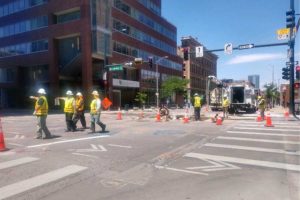By Navjoy
Navjoy helped The City and County of Denver’s Department of Transportation and Infrastructure (DOTI) plan, procure, deploy, and validate Bluetooth reader travel time devices on three corridors – Federal Boulevard, 56th Avenue and Hampden Avenue. The goal of this project was to install the devices and validate the accuracy of the travel time data that Denver would us for travel time monitoring and historical analysis.

Once installed, a study was conducted to validate the newly collected Bluetooth travel time data and intersection delay data on Federal Boulevard. Field observations of intersection delay, probe-vehicle travel runs, and INRIX travel times were used to create a comprehensive set of data that was then compared against the Bluetooth data. Note that both INRIX and Bluetooth travel time data were being compared to the “ground truth” probe-vehicle travel runs.
The comparisons were used to create numerous statistical outputs. For example, the travel time between intersections could be compared for traffic purposes (i.e., how many seconds it took to travel between Intersection A and Intersection B). Percent differences between the three collection methods were also reported. In essence, the data comparisons validated the precision of the Bluetooth devices and helped understand pros and cons of each travel time data source.
Travel time data can be used to improve corridor signal timing. Slower travel time areas can indicate problematic intersections or unusual traffic volumes. Once deployed, the transportation agency can focus on these areas to improve overall traffic and travel time. Additionally, it can be used to monitor corridors in real-time and detect congestion-causing events such as incidents by selling up thresholds.
From there, a final Bluetooth Validation Study was produced that informed future Bluetooth reader deployments and best practices. The devices remain key tools for travel time data collection in Denver.
To learn more about Bluetooth reader deployments and applicability to your agency, please reach out to communication@navjoyinc.com.
